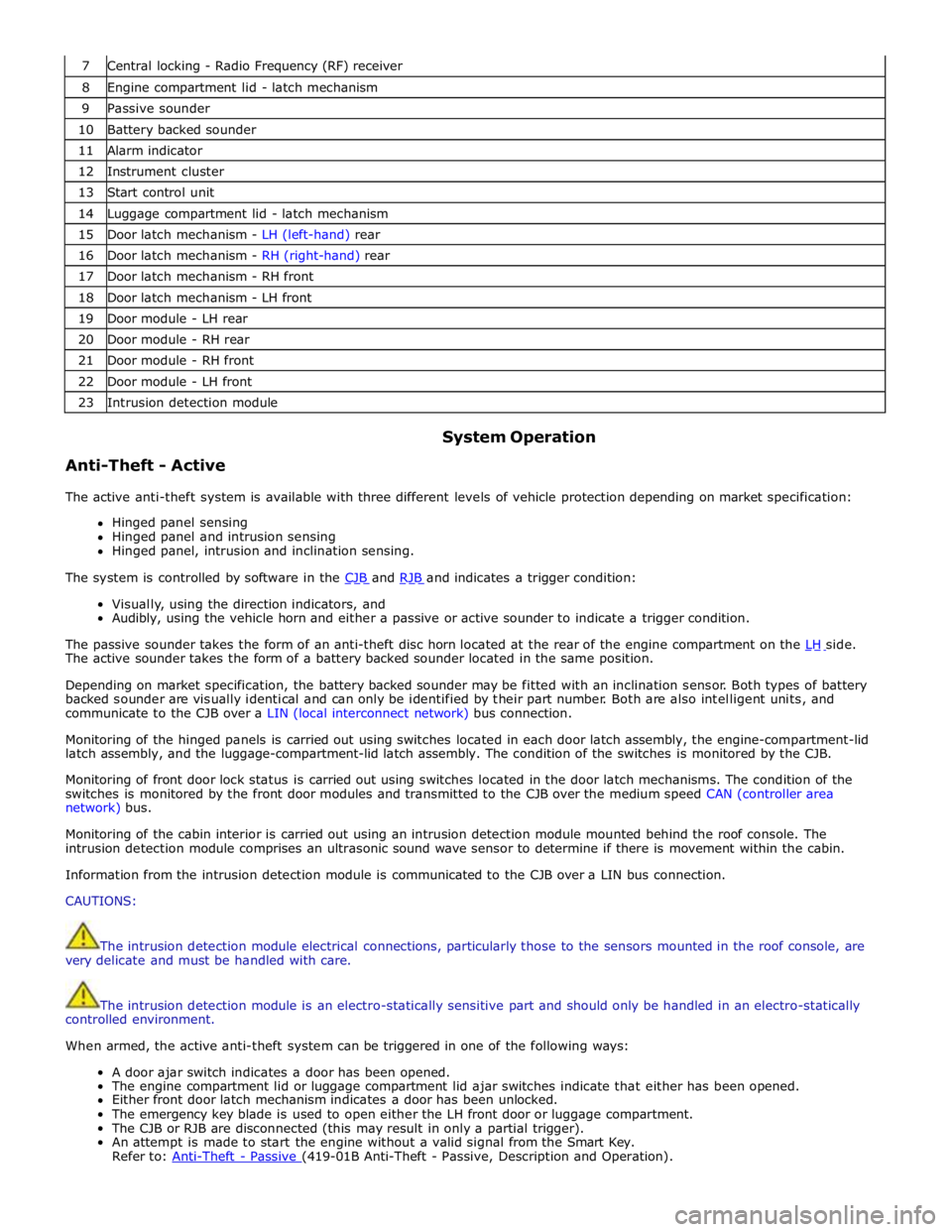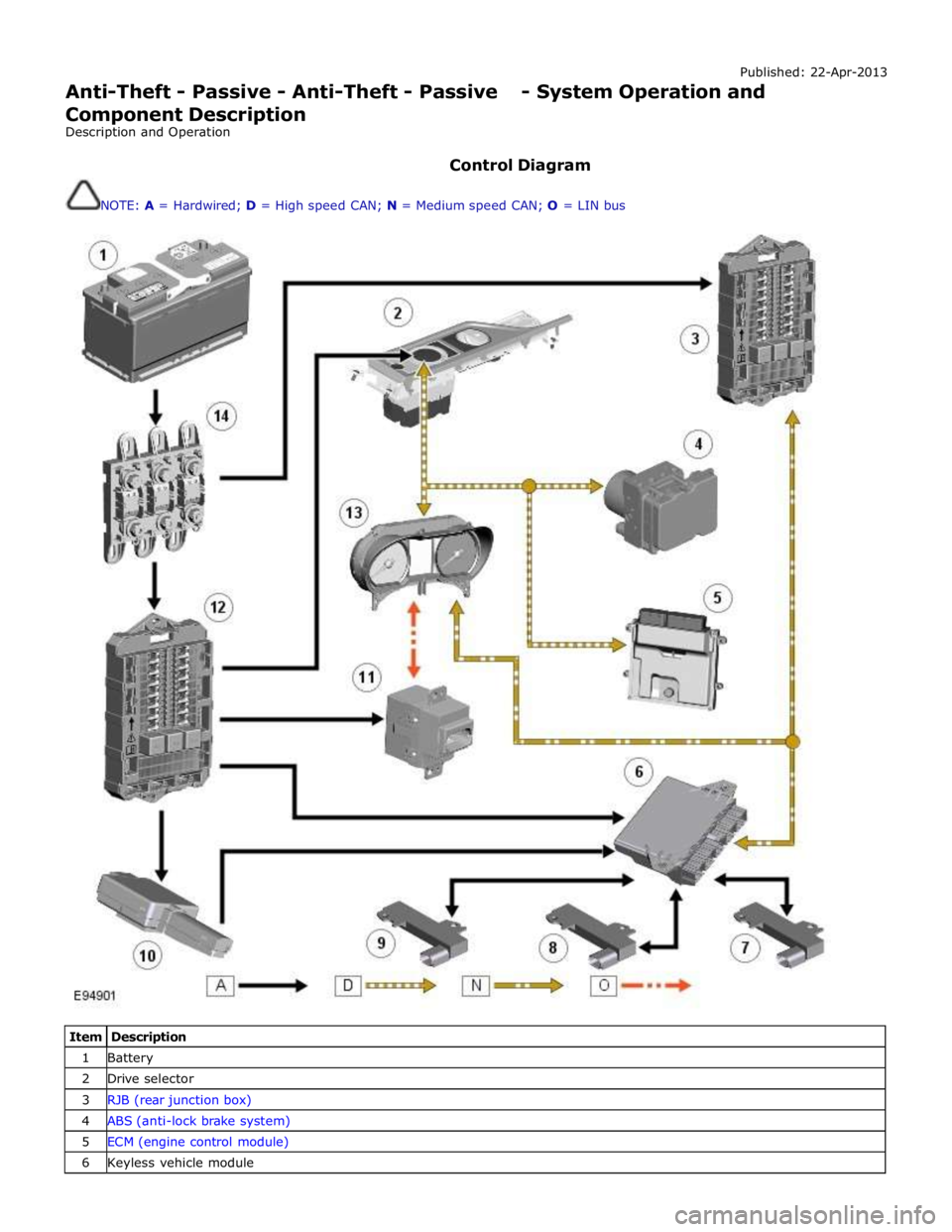2010 JAGUAR XFR lock
[x] Cancel search: lockPage 2123 of 3039

7 Central locking - Radio Frequency (RF) receiver 8 Engine compartment lid - latch mechanism 9 Passive sounder 10 Battery backed sounder 11 Alarm indicator 12 Instrument cluster 13 Start control unit 14 Luggage compartment lid - latch mechanism 15 Door latch mechanism - LH (left-hand) rear 16 Door latch mechanism - RH (right-hand) rear 17 Door latch mechanism - RH front 18 Door latch mechanism - LH front 19 Door module - LH rear 20 Door module - RH rear 21 Door module - RH front 22 Door module - LH front 23 Intrusion detection module
Anti-Theft - Active System Operation
The active anti-theft system is available with three different levels of vehicle protection depending on market specification:
Hinged panel sensing
Hinged panel and intrusion sensing
Hinged panel, intrusion and inclination sensing.
The system is controlled by software in the CJB and RJB and indicates a trigger condition: Visually, using the direction indicators, and
Audibly, using the vehicle horn and either a passive or active sounder to indicate a trigger condition.
The passive sounder takes the form of an anti-theft disc horn located at the rear of the engine compartment on the LH side. The active sounder takes the form of a battery backed sounder located in the same position.
Depending on market specification, the battery backed sounder may be fitted with an inclination sensor. Both types of battery
backed sounder are visually identical and can only be identified by their part number. Both are also intelligent units, and
communicate to the CJB over a LIN (local interconnect network) bus connection.
Monitoring of the hinged panels is carried out using switches located in each door latch assembly, the engine-compartment-lid
latch assembly, and the luggage-compartment-lid latch assembly. The condition of the switches is monitored by the CJB.
Monitoring of front door lock status is carried out using switches located in the door latch mechanisms. The condition of the
switches is monitored by the front door modules and transmitted to the CJB over the medium speed CAN (controller area
network) bus.
Monitoring of the cabin interior is carried out using an intrusion detection module mounted behind the roof console. The
intrusion detection module comprises an ultrasonic sound wave sensor to determine if there is movement within the cabin.
Information from the intrusion detection module is communicated to the CJB over a LIN bus connection.
CAUTIONS:
The intrusion detection module electrical connections, particularly those to the sensors mounted in the roof console, are
very delicate and must be handled with care.
The intrusion detection module is an electro-statically sensitive part and should only be handled in an electro-statically
controlled environment.
When armed, the active anti-theft system can be triggered in one of the following ways:
A door ajar switch indicates a door has been opened.
The engine compartment lid or luggage compartment lid ajar switches indicate that either has been opened.
Either front door latch mechanism indicates a door has been unlocked.
The emergency key blade is used to open either the LH front door or luggage compartment.
The CJB or RJB are disconnected (this may result in only a partial trigger).
An attempt is made to start the engine without a valid signal from the Smart Key.
Refer to: Anti-Theft - Passive (419-01B Anti-Theft - Passive, Description and Operation).
Page 2124 of 3039

The battery backed sounder is disconnected (partial trigger only).
The vehicle battery is disconnected on a vehicle fitted with a battery backed sounder (partial trigger only).
The inclination sensor detects a change in vehicle attitude.
The intrusion detection module detects movement within the cabin.
Door Modules Component Description
The door modules provide the interface between the door latch-motors, the door latch-switches and the CJB. The door modules
provide door switch status information and enable the door latch-motors on request from the CJB or the keyless vehicle
module.
Keyless Vehicle Module
The keyless vehicle module interfaces with the Central locking, Radio Frequency (RF) receiver and collects RF signal information
which is transmitted from the Smart Key. This information is translated into commands which are passed on the medium speed
CAN bus to the:
CJB,
RJB,
door modules, and
instrument cluster.
The keyless vehicle module also monitors:
2 interior antennae,
1 luggage compartment antenna,
a rear bumper antenna, and
4 door handle antennae if the passive entry system is fitted.
On vehicles with passive entry, the additional fast latch motors are controlled via the keyless vehicle module and the locking
status is passed to the CJB on the medium speed CAN bus.
Instrument Cluster
The instrument cluster controls the alarm indicator, and in conjunction with the ECM (engine control module), the engine
immobilization. The ECM controls the engine crank and fuel functions and the instrument cluster processes the valid
transponder information.
Alarm Indicator
The alarm indicator is a LED (light emitting diode) located in the body of the sunload/light sensor. When the ignition is off the
indicator gives a visual indication of the active anti-theft system to show if the alarm system is active or not active. Operation
of the alarm indicator is controlled by the instrument cluster which varies the flash rate of the LED to indicate the system
status of the alarm and the immobilization systems.
When the ignition is on, the indicator provides a visual indication of the status of the passive anti-theft (engine
immobilization) system. If the immobilization system is operating correctly, the LED will be illuminated for 3 seconds at
ignition on and then extinguish. If a fault exists in the immobilization system, the LED will be either permanently illuminated
or flashing for 60 seconds. This indicates that a fault exists and fault code has been recorded. After the 60 second period the
LED will flash at different frequencies which indicate the nature of the fault.
Refer to: Anti-Theft - Passive (419-01B Anti-Theft - Passive, Description and Operation).
Passive Anti-Theft Horn
The passive anti-theft horn is hardwired to the CJB which activates the horn when the alarm is triggered.
Battery Backed Sounder
Operation of the battery backed sounder is controlled by the CJB on the LIN bus. The sounder is also connected with a
permanent battery supply via the CJB. An integral, rechargeable battery powers the sounder if the battery power supply from
the CJB is interrupted.
Dependant on vehicle, a incitation sensor is incorporated into the battery backed sounder, to monitor vehicle attitude, see
Inclination Sensor.
Inclination Sensor
The CJB monitors the inclination sensor and will activate the alarm system if the vehicle is being raised.
Intrusion Detection Module
The intrusion detection module comprises an ultrasonic sound wave sensor which monitors the vehicle's interior.
The intrusion detection module is activated with volumetric mode which in turn is enabled when the vehicle is double locked.
The vehicle can be locked and alarmed with the module de-activated if a pet is to be left in the vehicle for example by single-
Page 2125 of 3039

locking the active anti-theft system. The intrusion detection modules can also be de-activated by deselecting the 'Alarm
Sensors' option in the 'Vehicle Settings' screen on the Touch Screen Display.
NOTE: The Touch Screen method of de-activation of the intrusion detection module is only for one arm cycle, it will revert
to active once the engine is next started.
When the volumetric mode is active and the vehicle battery voltage falls below 9 volts, the CJB will ignore any inputs from the
intrusion detection module to prevent false alarm activation.
www.JagDocs.com
Page 2127 of 3039

Check DDW for open campaigns. Refer to the corresponding bulletins and SSMs which may be valid for the specific
customer complaint and carry out the recommendations as required.
DTC Description Possible Causes Action B1087-83
LIN Bus "A" - Value of
signal protection
calculation incorrect
Checksum of the received LIN
frame from battery backed
sounder, roof header console,
and/or rain/light sensor is
incorrect
Check operation of rain/light sensor by
covering sensor or applying water to screen,
install a new sensor as required B1087-88 LIN Bus "A" - Bus off
Bus off. Battery backed sounder,
roof header console, and/or
rain/light sensor LIN circuit -
short to ground, power
Carry out any pinpoint tests associated with
this DTC using the manufacturer approved
diagnostic system. Refer to the electrical
circuit diagrams and check battery backed
sounder, roof header console, and rain/light
sensor LIN circuit for short to ground, power B108F-23
Cabin Lock/Unlock
Switch - Signal stuck
low
Cabin lock/unlock switch signal
stuck
Switch pressed for longer than
20 seconds
Switch circuit short circuit to
power or ground
Switch failure
Check the switch operation and
serviceability. Refer to the electrical circuit
diagrams and check the switch circuit B109C-11
Front Courtesy Light -
Circuit short to ground
Short to ground
Refer to the electrical circuit diagrams and
test front courtesy light circuit for short to
ground B109C-15
Front Courtesy Light -
Circuit short to battery
or open
Short to power or open circuit
Refer to the electrical circuit diagrams and
test front courtesy light circuit for short to
power or open circuit B10EB-11
Driver Door Double
Locking Motor - Circuit
short to ground
Driver door double locking motor
control circuit - short to ground
Refer to the electrical circuit diagrams and
test driver door double locking motor control
circuit for short ground B10EB-15
Driver Door Double
Locking Motor - Circuit
short to battery or open
Driver door double locking motor
control circuit - short to power,
open circuit
Carry out any pinpoint tests associated with
this DTC using the manufacturer approved
diagnostic system. Refer to the electrical
circuit diagrams and test driver door double
locking motor control circuit for short to
power or open circuit B10EC-11
Passenger Door Double
Locking Motor - Circuit
short to ground
Passenger door double locking
motor control circuit - short to
ground
Refer to the electrical circuit diagrams and
test passenger door double locking motor
control circuit for short ground B10EC-15
Passenger Door Double
Locking Motor - Circuit
short to battery or open
Passenger door double locking
motor control circuit - short to
power, open circuit
Carry out any pinpoint tests associated with
this DTC using the manufacturer approved
diagnostic system. Refer to the electrical
circuit diagrams and test passenger door
double locking motor control circuit for short
to power or open circuit B10ED-11
Rear Door Driver Side
Double Locking Motor -
Circuit short to ground
Rear door driver side double
locking motor control circuit -
short to ground
Refer to the electrical circuit diagrams and
test rear door driver side double locking
motor control circuit for short ground B10ED-15
Rear Door Driver Side
Double Locking Motor -
Circuit short to battery
or open
Rear door driver side double
locking motor control circuit -
short to power, open circuit
Carry out any pinpoint tests associated with
this DTC using the manufacturer approved
diagnostic system. Refer to the electrical
circuit diagrams and test rear door driver
side double locking motor control circuit for
short power, open circuit
Page 2128 of 3039

DTC Description Possible Causes Action B10EE-11
Rear Door Passenger
Side Double Locking
Motor - Circuit short to
ground
Rear door passenger side double
locking motor control circuit -
short to ground
Refer to the electrical circuit diagrams and
test rear door passenger side double locking
motor control circuit for short ground B10EE-15
Rear Door Passenger
Side Double Locking
Motor - Circuit short to
battery or open
Rear door passenger side double
locking motor control circuit -
short to power, open circuit
Carry out any pinpoint tests associated with
this DTC using the manufacturer approved
diagnostic system. Refer to the electrical
circuit diagrams and test rear door
passenger side double locking motor control
circuit for short power, open circuit B10F1-11
Key In Switch - Circuit
short to ground
Keyless vehicle module, key IN
status circuit - short to ground
Carry out any pinpoint tests associated with
this DTC using the manufacturer approved
diagnostic system. Refer to the electrical
circuit diagrams and check keyless vehicle
module, key IN status circuit for short to
ground B10F1-12
Key In Switch - Circuit
short to battery
Keyless vehicle module, key IN
status circuit - short to power
Refer to the electrical circuit diagrams and
check keyless vehicle module, key IN status
circuit for short to power B10F1-13
Key In Switch - Circuit
open
Keyless vehicle module, key IN
status circuit - open circuit
Refer to the electrical circuit diagrams and
check keyless vehicle module, key IN status
circuit for open circuit B1108-11
Driver Door Central
Locking Motor - Circuit
short to ground
Driver door central locking motor
control circuit - short to ground
Refer to the electrical circuit diagrams and
test driver door central locking motor control
circuit for short ground B1108-15
Driver Door Central
Locking Motor - Circuit
short to battery or open
Driver door central locking motor
control circuit - short to power,
open circuit
Carry out any pinpoint tests associated with
this DTC using the manufacturer approved
diagnostic system. Refer to the electrical
circuit diagrams and test driver door central
locking motor control circuit for short to
power, open circuit B1109-11
Passenger Door Central
Locking Motor - Circuit
short to ground
Short to ground
Refer to the electrical circuit diagrams and
test passenger door central locking motor
circuit for short to ground B1109-15
Passenger Door Central
Locking Motor - Circuit
short to battery or open
Short to power or open circuit
Refer to the electrical circuit diagrams and
test passenger door central locking motor
circuit for short to power or open circuit B110A-11
Rear Door Driver Side
Central Locking Motor -
Circuit short to ground
Rear driver door central locking
motor control circuit - short to
ground
Refer to the electrical circuit diagrams and
test rear driver door central locking motor
control circuit for short ground B110A-15
Rear Door Driver Side
Central Locking Motor -
Circuit short to battery
or open
Rear driver door central locking
motor control circuit - short to
power, open circuit
Refer to the electrical circuit diagrams and
test rear driver door central locking motor
control circuit for short to power, open circuit B110B-11
Rear Door Passenger
Side Central Locking
Motor - Circuit short to
ground
Rear passenger door central
locking motor circuit short circuit
to ground
Refer to the electrical circuit diagrams and
check the circuit B110B-15
Rear Door Passenger
Side Central Locking
Motor - Circuit short to
battery or open
Rear passenger door central
locking motor circuit short circuit
to power or open circuit
Refer to the electrical circuit diagrams and
check the circuit B1163-11
Left Mirror Heater
Output Short To Ground
- Circuit short to ground
Short to ground
Refer to the electrical circuit diagrams and
test left mirror heater output circuit for short
to ground
Page 2131 of 3039

DTC Description Possible Causes Action security. Clear the DTC and retest. If the
problem persists, renew the driver door
window switch B11F6-11
Driver Folding Mirror
Motor - Circuit short to
ground
Driver folding mirror motor
circuit short circuit to ground
Mirror motor failure
Refer to the electrical circuit diagrams and
check the mirror fold circuit between the
drivers door module and the mirror
assembly. Repair as necessary B11F6-15
Driver Folding Mirror
Motor - Circuit short to
battery or open
Driver mirror heater output
circuit short circuit to power or
open circuit
Mirror motor failure
Refer to the electrical circuit diagrams and
check the mirror fold circuit between the
drivers door module and the mirror
assembly. Repair as necessary B11F7-11
Passenger Folding Mirror
Motor - Circuit short to
ground
Passenger folding mirror motor
circuit short circuit to ground
Mirror motor failure
Refer to the electrical circuit diagrams and
check the mirror fold circuit between the
passenger door module and the mirror
assembly. Repair as necessary B11F7-15
Passenger Folding Mirror
Motor - Circuit short to
battery or open
Passenger mirror heater output
circuit short circuit to power or
open circuit
Mirror motor failure
Refer to the electrical circuit diagrams and
check the mirror fold circuit between the
passenger door module and the mirror
assembly. Repair as necessary B1222-23
Master Lock/Unlock
Switch - Signal stuck
low
Master lock or unlock switch
digital input circuit - signal
stuck low
Refer to the electrical circuit diagrams and
check master lock and unlock switch digital
input circuits for short to ground, open
circuit B1A98-83
LIN Bus Circuit #1 -
Value of signal
protection calculation
incorrect
Value of signal protection
calculation incorrect
Refer to the electrical circuit diagrams and
check the LIN Bus circuit between the rear
door control unit and the Driver Door
Module. Check the connectors for integrity
and security. Clear the DTC and retest. If
the problem persists, renew the rear door
control module B1A98-86
LIN Bus Circuit #1 -
Signal invalid
Signal invalid
Refer to the electrical circuit diagrams and
check the LIN Bus circuit between the rear
door control unit and the Driver Door
Module. Check the connectors for integrity
and security. Clear the DTC and retest. If
the problem persists, renew the rear door
control module B1A98-87
LIN Bus Circuit #1 -
Missing message
Missing message
Refer to the electrical circuit diagrams and
check the LIN Bus circuit between the rear
door control unit and the Driver Door
Module. Check the connectors for integrity
and security. Clear the DTC and retest. If
the problem persists, renew the rear door
control module B1C09-11
Driver Left/Right Mirror
Motor Circuit - Circuit
short to ground
Driver mirror adjustment motor
circuit short circuit to ground
Mirror left/right motor failure
Refer to the electrical circuit diagrams and
check the mirror motor circuit between the
drivers door module and the mirror
assembly. Repair as necessary B1C09-15
Driver Left/Right Mirror
Motor Circuit - Circuit
short to battery or open
Driver mirror adjustment motor
circuit short circuit to power or
open circuit
Mirror left/right motor failure
Refer to the electrical circuit diagrams and
check the mirror motor circuit between the
drivers door module and the mirror
assembly. Repair as necessary B1C10-11
Driver Up/Down Mirror
Motor Circuit - Circuit
short to ground
Driver mirror adjustment motor
circuit short circuit to ground
Mirror motor failure
Refer to the electrical circuit diagrams and
check the mirror motor circuit between the
drivers door module and the mirror
assembly. Repair as necessary
Page 2133 of 3039

DTC Description Possible Causes Action B1C39-29
Key Lock Switch - Signal
invalid
Key lock switch signal invalid,
stuck/jammed
Switch held for longer than 20
seconds
Key lock switch circuit short to
ground (where connected)
Key lock switch failure
Central Junction Box fault
Refer to the electrical circuit diagrams and
the key lock switch circuit. Clear the DTC
and retest. If no other DTCs are present,
ignore this fault. If the DTC returns, suspect
an internal fault with the Central Junction
Box. Refer to the warranty policy and
procedures manual if a module is suspect B1D06-11
Left Turn Indicator -
Circuit short to ground
Left turn signal short circuit to
ground
Refer to the electrical circuit diagrams and
check left turn signal for short circuit to
ground B1D06-15
Left Turn Indicator -
Circuit short to battery
or open
Left turn signal short circuit to
power
Left turn signal high resistance,
open circuit
Refer to the electrical circuit diagrams and
check left turn signal for short circuit high
resistance, open circuit B1D07-11
Right Turn Indicator -
Circuit short to ground
Right turn signal short circuit to
ground
Refer to the electrical circuit diagrams and
check right turn signal for short circuit to
ground B1D07-15
Right Turn Indicator -
Circuit short to battery
or open
Right turn signal circuit short
circuit to power
Right turn signal circuit high
resistance, open circuit
Refer to the electrical circuit diagrams and
check right turn signal for short circuit high
resistance, open circuit B1D17-11 Battery Backed Sounder
- Circuit short to ground
Battery backed sounder
inclination sensor control circuit
- short to ground
Refer to the electrical circuit diagrams and
check battery backed sounder inclination
sensor control circuit for short to ground B1D18-11
Volumetric Sensor -
Circuit short to ground
Intrusion sensor module supply
circuit - short to ground
Carry out any pinpoint tests associated with
this DTC using the manufacturer approved
diagnostic system. Refer to the electrical
circuit diagrams and check intrusion sensor
module supply circuit for short to ground B1D97-96 Tilt Sensor - Component
internal failure
Component internal failure
Suspect the battery backed sounder, check
and install a new battery backed sounder as
required C1B14-11
Sensor Supply #1 -
Circuit short to ground
Short to ground
Refer to the electrical circuit diagrams and
test window sensor supply circuit for short
to ground C1B14-15
Sensor Supply #1 -
Circuit short to battery
or open
Short to power or open circuit
Refer to the electrical circuit diagrams and
test window sensor supply circuit for short
to power or open circuit C1B15-11 Sensor Supply Voltage A
- Circuit short to ground
Position sensor supply circuit
short to ground
Position sensor fault
Refer to the electrical circuit diagrams and
check the position sensor supply circuit
between the rear door module and the
window motor. If the problem persists,
renew the window motor C1B15-15 Sensor Supply Voltage A
- Circuit short to battery
or open
Position sensor supply circuit
short to power or open circuit
Position sensor fault
Refer to the electrical circuit diagrams and
check the position sensor supply circuit
between the rear door module and the
window motor. If the problem persists,
renew the window motor P1624-13
Anti-Theft System -
Circuit open
RJB anti-theft signal circuit -
open circuit
Refer to the electrical circuit diagrams and
check RJB anti-theft signal circuit for open
circuit
Page 2142 of 3039

Published: 22-Apr-2013
Anti-Theft - Passive - Anti-Theft - Passive - System Operation and
Component Description
Description and Operation
Control Diagram
NOTE: A = Hardwired; D = High speed CAN; N = Medium speed CAN; O = LIN bus
Item Description 1 Battery 2 Drive selector 3 RJB (rear junction box) 4 ABS (anti-lock brake system) 5 ECM (engine control module) 6 Keyless vehicle module